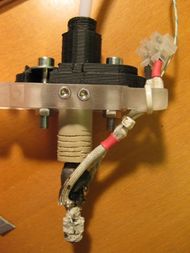Erik's Bowden Extruder
This page is a development stub. Please enhance this page by adding information, cad files, nice big images, and well structured data!
Release status: unknown
| Description | A fast bwoden extruder design
|
| License | unknown
|
| Author | |
| Contributors | |
| Based-on | |
| Categories | |
| CAD Models | |
| External Link |
The Bowden principle
The Bowden cable lets you reduce the moving mass of the extruder and thus allowing faster controlled motion, less shaking of your machine, less energy use and importantly: faster printing! Normally the mechanism that drives the filament into the hot end (where it melts) is directly on top of the extruder. This not only creates problems of balance and oscillations with faster motion which you can see in your printing results and hear and feel when your machine is shaking.
If the filament drive mechanism is placed on a non-moving part of the 3D printer, it can be pushed into a tube. PTFE (Teflon(tm) is useful because it is slippery: it little friction with the plastic. This limits wear and loss of energy. The tube's other end is connected to the extruder's hot-end.
The concept of using a Bowden cable as guide was suggested and pioneered by Ed Sells. See his post here: blog.reprap.org/2009/04/bowden-extruder-concept.html
Benfits
The lighter the extruder is, the quicker you can move the toolhead(s), e.g. when you're not extruding. The machine will need less current to run the motors and it reduces stringing when not extruding. Even more so, it reduces the moving mass of the X-axis so much that a much simpler and lighter Cartesian bot is possible. The steel rods wouldn't necessarily be needed, allowing a much larger ratio of self-replication. The Bowden cable itself could be printed in several modules that snap together. This guide could be lined with telfon-tape (available in every hardware store) that can be replaced when worn.
Drawback
The Bowden cable system has one major drawback. The need for a control mechanism that accounts for pressure on the filament is needed. The tube is a bit flexible, and so is the plastic filament. This makes the assembly a bit springy. But when you use a flow-control system that accounts for pressure, you will end up with much better quality. The extrusion starts and stops *very* sharply. You can do this by pulling back after extruding a segment. After that, you push it in as much as you pulled it back and simply start extruding again. You do need stepper based extrusion to adequately be able to control how much the filament is pushed into the extruder and pulled back out.
Several couplings have been suggested to affix the slippery PTFE at either end:
- Glueing it on, not a very good solution, I found - http://www.thingiverse.com/thing:996
- Threading a nut onto the end, using a printed coupling - http://www.thingiverse.com/thing:1899 (Darwin) http://www.thingiverse.com/thing:2221 (Mendel)
- Push-to-fit coupling, you can push in the PTFE and it will have a pretty tight friction fit - http://www.thingiverse.com/thing:3775
- Removing a 'ring' of PTFE and using a Circlip - http://www.thingiverse.com/image:18270
The first two solutions contain more details on the Bowden extruder system.
